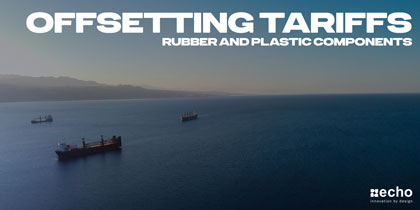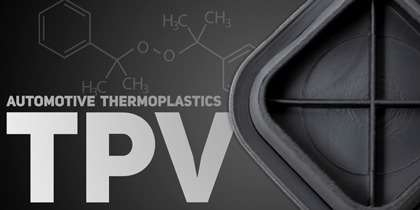Mitigating Tariffs: Converting EPDM Components to TPE
-

- Apr 28, 2025

The rising impact of tariffs on imports from China presents real challenges for manufacturers across multiple industries. For companies that rely on compression-molded EPDM rubber components sourced from overseas, the added costs, supply chain disruptions, and long lead times are squeezing margins and threatening production schedules.
At Echo Engineering, we’ve been working closely with our customers to rethink how to stay competitive without sacrificing performance. One of the most creative and effective ways we’ve found to help mitigate tariff-related risk is by converting EPDM rubber components into domestically manufactured injection-molded thermoplastic elastomer (TPE) alternatives.
Here’s how this switch can help your business weather the tariff storm, while even improving part performance and supply chain efficiency.
What Are TPEs—and How Do They Compare to Traditional Rubber?
Thermoplastic elastomers (TPEs) are a family of materials that combine the performance characteristics of rubber with the processing advantages of plastics. They’re flexible, durable, and resilient—just like traditional elastomers such as EPDM—but they can be injection molded and reprocessed like a thermoplastic.
This makes TPEs a perfect fit for components that need to be soft, compressible, or elastic, but also benefit from tight tolerances, high repeatability, and scalable domestic manufacturing.
Why Are EPDM Components Typically Made Overseas?
For decades, compression-molded EPDM rubber components have been produced in regions like China, Taiwan, and Southeast Asia. The reasons are rooted in both cost and legacy infrastructure.
-
Lower Labor and Production Costs: Compression molding is labor-intensive and time-consuming. Overseas manufacturers—especially in China—have historically offered significantly lower labor rates and material costs, making them the go-to for high-volume, low-cost rubber components.
-
Established Supply Chains: Many OEMs and tier suppliers have long-standing relationships with overseas EPDM suppliers. These vendors often already have the tooling, material sourcing, and manufacturing processes, reducing upfront investment.
-
Capacity for Large-Scale Molding: Countries like China have invested heavily in rubber production infrastructure. From raw compound mixing to large-format compression presses, they’re built to support large volumes of rubber parts at relatively low cost.
-
Tooling Cost Incentives: Some overseas suppliers offer deeply discounted tooling for high-volume orders. That can be appealing—until you factor in the long lead times, shipping delays, and tariff risk that come with it.
-
Perceived Cost Savings: On paper, the per-part cost of an overseas EPDM component may appear cheaper. But when you add in hidden costs—tariffs, freight, quality control, and the risk of extended downtime from late shipments—that cost advantage can quickly disappear.
Why the EPDM-to-TPE Conversion Makes Sense Now
Reduce Tariff Impact
Compression-molded EPDM rubber is frequently imported from China, making it subject to steep and unpredictable tariff rates. By converting these components to TPE, which can be injection molded in the U.S., companies can eliminate or significantly reduce tariff-related costs.
Improve Lead Times
Domestic TPE molding facilities, like Echo Engineering’s Ammex Plastics facility, offer shorter lead times compared to overseas EPDM suppliers. You’re no longer waiting 8-12 weeks for parts to ship from China—your components can be produced and delivered in days or weeks instead after tooling is completed.
Enable Design Flexibility
TPE materials are processed via injection molding, opening the door for complex geometries, overmolding, and integrated design features that aren't always feasible with traditional compression-molded rubber. That means you can often combine multiple parts into one, streamline assembly, or enhance fit and function—all without inflating tooling costs.
Sustainability Gains
Many TPEs are recyclable and more environmentally friendly than thermoset rubbers like EPDM. If sustainability is a growing part of your company’s mission, this switch could offer benefits beyond just cost savings.
Types of TPEs: Spotlight on TPV
One of the most relevant subcategories of TPEs for EPDM replacement is TPV—thermoplastic vulcanizate. TPVs are made by dynamically cross-linking rubber particles (typically EPDM) within a thermoplastic matrix, often polypropylene. The result is a material that behaves similarly to vulcanized rubber but can still be processed with standard injection molding techniques.
Key TPV benefits include:
-
Good resistance to heat, weathering, and chemicals
-
High elasticity and long-term compression set resistance
-
Recyclability and good processability
-
Available in multiple hardness levels to match specific application needs
Because TPVs share many of the same base properties as EPDM—especially in terms of durability and outdoor performance—they are one of the go-to solutions when converting compression-molded EPDM parts to injection-molded designs.
A Real-World Example: Automotive Panel Plugs
Automotive panel plugs have typically been compression molded using EPDM over the years. With tariffs now playing an unpredictable factor in this, some of our customers have made the shift to TPV panel plugs.
Outside of the tariff side of this decision, a few other benefits as to why this decision makes sense include:
-
Material Savings: Price of TPV compared to EPDM, as well as TPV's recyclability vs. EPDM's scrap
-
Weight: TPV panel plugs typically have thinner wall sections, which help minimize the material volume and weight (20%-30% decrease in weight in certain cases)
-
Color: Even though the majority of plugs are not visible to the end consumer, TPV retains its color much better than EPDM. This is more of a factor for the other components on a vehicle made using TPV
If you’re considering shifting to TPE / TPV, our engineering team can evaluate the design and material requirements, then recommend a TPE compound with comparable sealing, temperature, and chemical resistance properties. Once validated, we domestically produce the part via injection molding at Ammex Plastics. This reduces lead time, cuts costs, and removes the volatility of overseas sourcing.
Not Every EPDM Component Is a Fit—But Many Are
We’re not saying TPE is a perfect swap for every EPDM application. But in our experience, many non-critical seals, plugs, grommets, and vibration-dampening components can be converted without compromising performance. Our material experts and design engineers collaborate with you to identify where the swap makes sense—and where it doesn’t.
Ready to Explore an EPDM-to-TPE Conversion?
Echo Engineering specializes in helping OEMs and tier suppliers turn material challenges into competitive advantages. If tariffs are putting pressure on your operations, let’s have a conversation about whether domestic TPE could be part of your solution.







